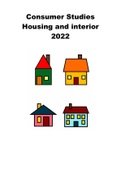Consumer Studies
Housing and interior
2022
,SAGS REQUIREMENTS
The following is the list of what you are required to learn as per the SAGS.
1. Explain the financial and contractual responsibilities of the occupants for different
housing options and identify the role players.
● Types of housing in South Africa (single dwelling, cluster etc. )
● Housing ownership options (Full title/freehold, sectional title)
● Different housing acquisition options (renting, buying, building)
● Advantages and disadvantages of each option
● Financial implication of each option
➔ Deposits (buying and renting)
➔ Bonds/mortgage loan, bank requirements for granting bonds
➔ Insurance (bond/life insurance, homeowners comprehensive insurance
and short term contents)
➔ Monthly repayments of bond/rental
➔ Transfer and other hidden costs
➔ Financial implications of running your own home (municipal costs, taxes)
➔ Contractual implications
● Identify the role players in accessing housing:
➔ Government housing schemes
➔ Financial and other housing NGOs
➔ Subsidies- state and employers
➔ The estate agent
➔ NHBRC
2. Compare and evaluate the choice of large household equipment, and explain the
financial, contractual and environmental responsibilities when purchasing such
equipment.
Analyse consumer responsibilities in the acquiring of large household equipment in
general with regard to:
● Choice
➔ Function
➔ Energy usage (Human and non Human)
➔ Water consumption
➔ The possible impact of technology
1
,Types of financial and contractual responsibilities
● Cash, credit cards, instalment sales transactions, layby, stokvel
● Relevant contracts
● Warranties and guarantees
●
Demonstrate an understanding of:
● Municipal services such as water, electricity, sanitation and waste removal
● The importance of waste control- reduce, reuse and recycle
● Sustainable electricity consumption
● Sustainable water consumption
For this section you need to use the Google Classroom copy as well so that you can open
some links.
2
, HOUSING OPTIONS
Different housing options are available to the South African consumer. Consumers need to make
rational decisions when choosing a place to live in. House types can vary:
● House on its own
This is a house on a piece of land, not joined to another house, but it can be close to
other houses. It can also be a group of houses in a complex, but they are not joined.
This is called cluster housing.
● House attached to another house
This can be in a complex called townhouses, or in can be two houses that are attached
called semi-detached houses
● Flats
High density houses, each has its own bathroom, kitchen and living areas. Communal
areas like corridors, stairwells, gardens and washlines are shared. Some have laundry
facilities as the kitchens are too small to house washing machines.
● Residence (school or university) a hostel (workers)
These have single or shared sleeping areas, communal bathrooms and a communal
kitchen or dining area.
● Mobile home (caravan)
This can be a caravan that can be moved from site to site. Many people holiday like this.
Some people move around due to the work they do, especially construction workers,
and prefabricated houses can be moved from area to area and set up with little effort.
● Tents
Often used by holiday makers but also set up for emergency housing.
● Shacks
Shelter is a basic need, and it is not pleasant to be out in the elements, so the very poor
people are forced to build homes with materials they can find.
3





